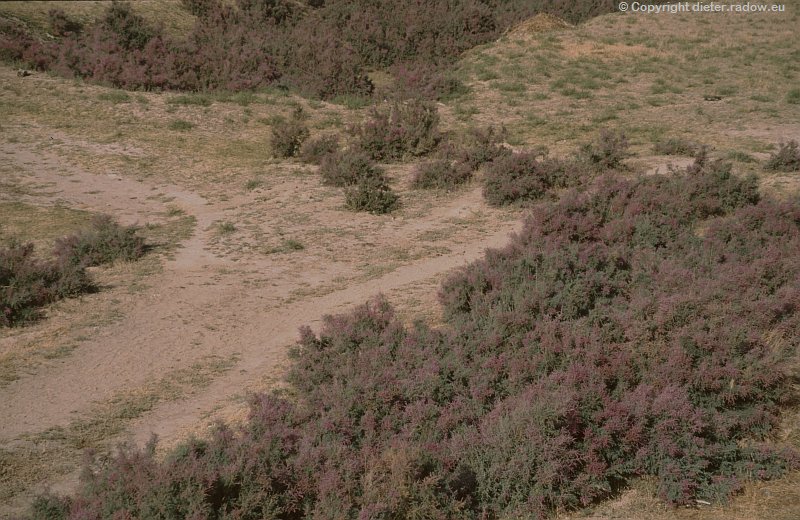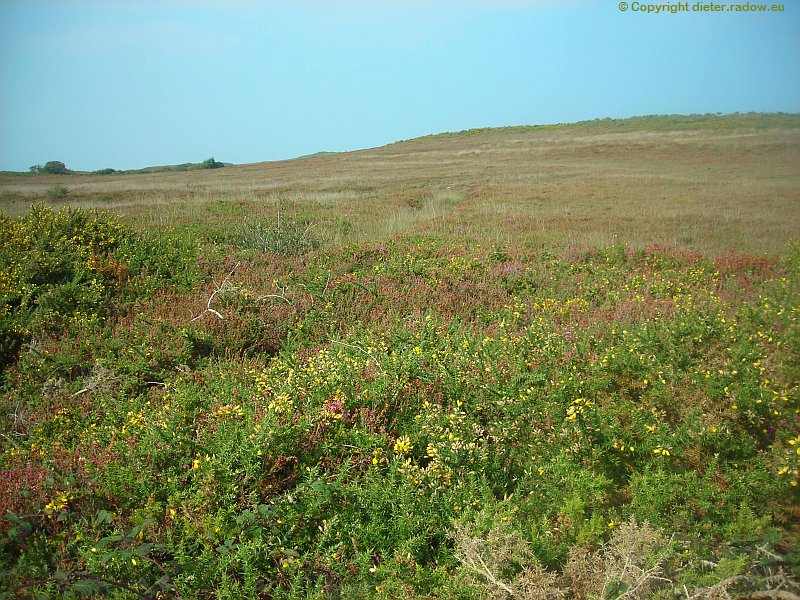Heathland
Heathland is a landform between forrest, trees, and bush on the one hand (foliage) and steppe (grass) on the other hand. Typical are small plants of different variety with thin wooden stem. They grow on poor soil of sand or highmoor and shed little organic components. Thus, differently from forrest there is scare enrichment of humus in the soil by the vegetation. As soon as trees begin to grow in heathland, heather-plants and the character of the heathland are going down. There- fore heathlands maintain as antropogenic landform especially there, where man is being preventing growth of trees by extensive pastural farming

Germany-Brandenburg between Oder and Spree : Reicherskreuz Heathland
beginning heather blossom Erica ° ° ° beginnende Heideblüte

Germany-Brandenburg between Oder and Spree :
beginning heather blossom Erica in the Reicherskreuz Heathland° ° ° beginnende Heideblüte in der Reicherskreuzer Heide

Germany-Brandenburg between Oder and Spree – Reicherskreuz Heathland :
beginning superseding of the heather by trees ° ° ° beginnende Verdrängung der Heide durch Baumwuchs
Germany – Lower Saxony – Luneburg Heathland ° ° ° Lüneburger Heide bei Overhaberbeck:
beginning superseding of the heath by trees ° ° ° beginnende Verdrängung der Heide durch Baumwuchs
Germany – Lower Saxony – Luneburg Heathland ° ° ° Lüneburger Heide bei Overhaberbeck:
beginning blossom fading of the heath ° ° ° Die Heide bei Oberhaverbeck beginnt zu verblühen
Germany: Luneburg Heath in full blossom (each second week in August) ° ° ° Lüneburger Heide in voller Blüte (zweite Woche im August)
Germany – Lower Saxony – Wilsede Hill: Luneburg Heath in full blossom (each second week in August)
Lüneburger Heide am Wilseder Berg in voller Blüte (zweite Woche im August)
Transition from heath to desert. We don´t speak of heath if the typical xerophyt stunted-growth-plants don´t cover less than 25 % of the surface
Übergang von Heide zur Wüste. Wir sehen noch xerophyte Zwergholzgewächse, jedoch spricht man nicht mehr von Heide, wenn die Vegetation weniger als 25 % der Oberfläche einnimmt.
Turkmenistan: Desert or steppe not heathland. We don´t speak of heath if heath typical stunted-growth-plants don´t cover less than 25 % of the surface- you see SAXAUL as leafless xerophytic shrub of greenish branches
Das ist Steppe. Man spricht nicht mehr von Heide, wenn deren typische Zwergholzgewächse (hier Haxaul) weniger als 25 % der Oberfläche einnehmen.

Uzbekistan ° ° ° The with heather thickly covered areas may be called heathland
Die dicht mit Steppenheide dicht bewachsenen Flächen kann man als Heideflächen bezeichnen.
Libya 1989 – semi desert behind the dunes at the coast. Humidity of the Mediterranian Sea makes growth of esoteric plants in the desert ground possible. But because less than 25 % of the surface is been covered, this area cannot been described as heatheland ° ° ° Libyen 1989 – Halbwüste hinter der Küstendüne. Luftfeuchtigkeit vom Mittelmeer macht hier den Wuchs von xerophyten Pflanzen im Wüstensand möglich. Da aber weniger als 25 % der Erdoberfläche von den Zwergholzgewächsen bedeckt ist, sprechen wir nicht von Heide.



